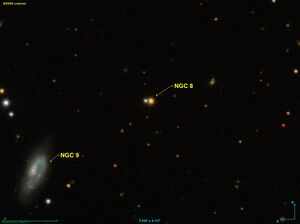Astronomy:NGC 8
| Observation data Equinox J2000.0]] (ICRS) | |
|---|---|
| Constellation | Pegasus |
| Right ascension | 00h 08m 45.3s[1] |
| Declination | +23° 50′ 20″[1] |
| Other designations | |
NGC 8 is an asterism of two completely unrelated stars[1] (spectral types K6I and G4)[citation needed] in the constellation Pegasus, discovered on 29 September 1865 by Otto Wilhelm von Struve.[2] It is approximately 2.7 arc minutes away from NGC 9.[3]
The two stars are completely unrelated to each other, with the whiter, dimmer star (2MASS J00084563+2350186[4]) being at a distance of 10400+4400
−2400 light years,[citation needed] and the yellower, brighter star (2MASS J00084521+2350184[5]) having a minimum distance of 215,000 light years.[citation needed] While both stars are technically outside the Milky Way's galactic disc, the nearer is 6400±2100 light-years south of the 1,000-light-year-thick disc, and the further is not only at least 130,000 light-years south of the disk, but is located entirely outside the Milky Way itself, being at least 220,000 light-years from the galactic core.[citation needed]
References
- ↑ 1.0 1.1 1.2 1.3 "NASA/IPAC Extragalactic Database". Results for NGC 0008. http://nedwww.ipac.caltech.edu/cgi-bin/nph-objsearch?objname=NGC+08&img_stamp=yes&extend=no.
- ↑ Steinicke, Wolfgang (2010). Observing and Cataloguing Nebulae and Star Clusters. Cambridge University Press. pp. 283. ISBN 9780521192675.
- ↑ "NASA/IPAC Extragalactic Database". Notes for object NGC 0008. http://nedwww.ipac.caltech.edu/cgi-bin/nph-datasearch?search_type=Note_id&objid=280.
- ↑ "Results for 2MASS J00084563+2350186". SIMBAD, Centre de Données Astronomiques de Strasbourg. http://simbad.u-strasbg.fr/simbad/sim-id?protocol=html&Ident=2MASS+J00084563%2B2350186.
- ↑ "Results for 2MASS J00084521+2350184". SIMBAD, Centre de Données Astronomiques de Strasbourg. http://simbad.u-strasbg.fr/simbad/sim-id?protocol=html&Ident=2MASS+J00084521%2B2350184.
External links
- NGC 8 on WikiSky: DSS2, SDSS, GALEX, IRAS, Hydrogen α, X-Ray, Astrophoto, Sky Map, Articles and images
Coordinates: ![]() 00h 08m 45.3s, +23° 50′ 20″
00h 08m 45.3s, +23° 50′ 20″
de:Liste der NGC-Objekte von 1 bis 500#Nr. 1 bis 100
 |


